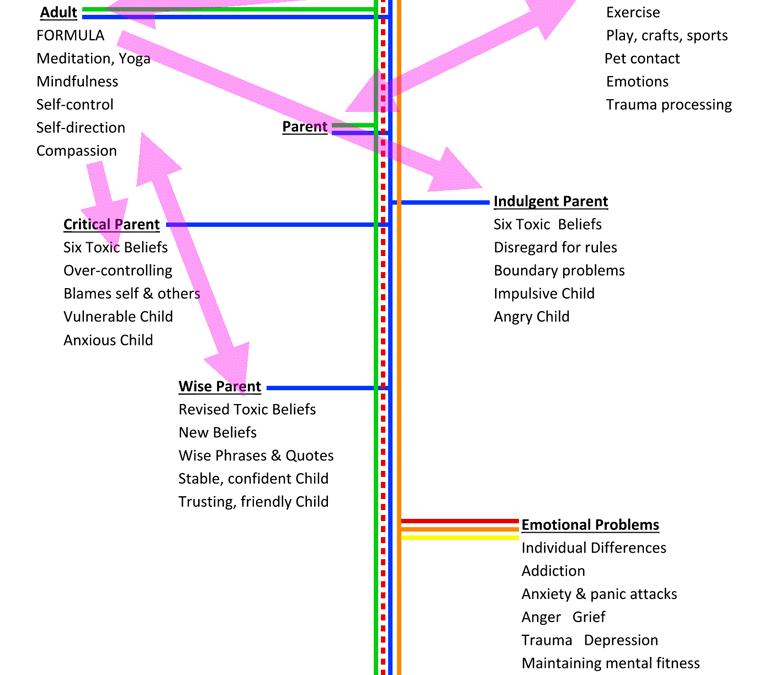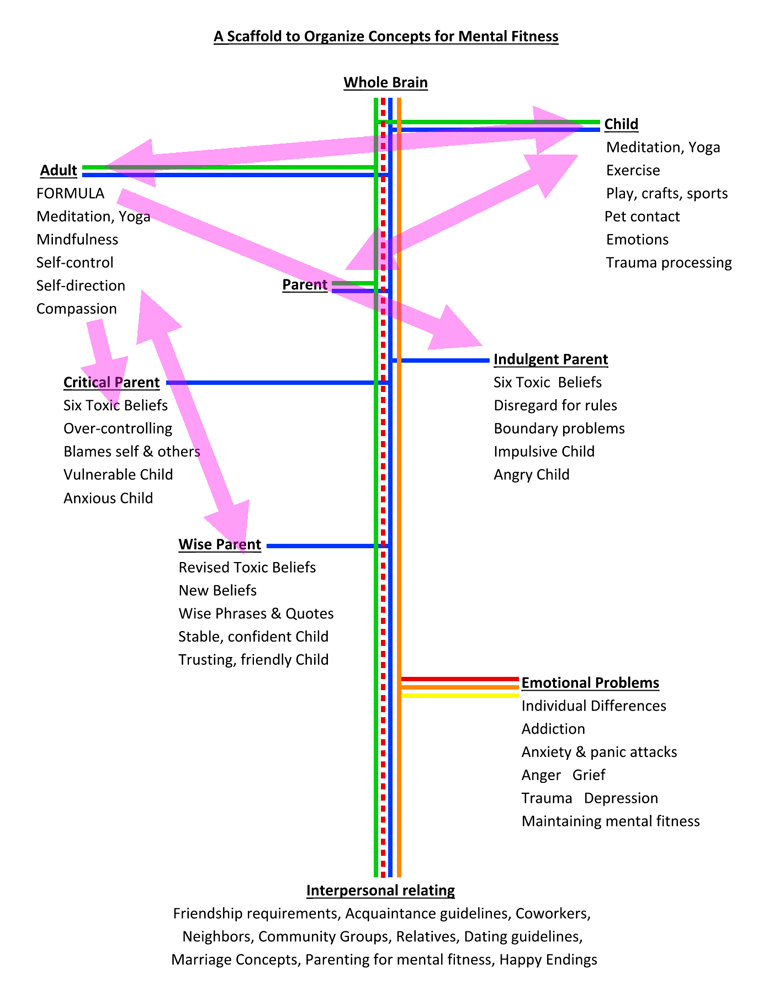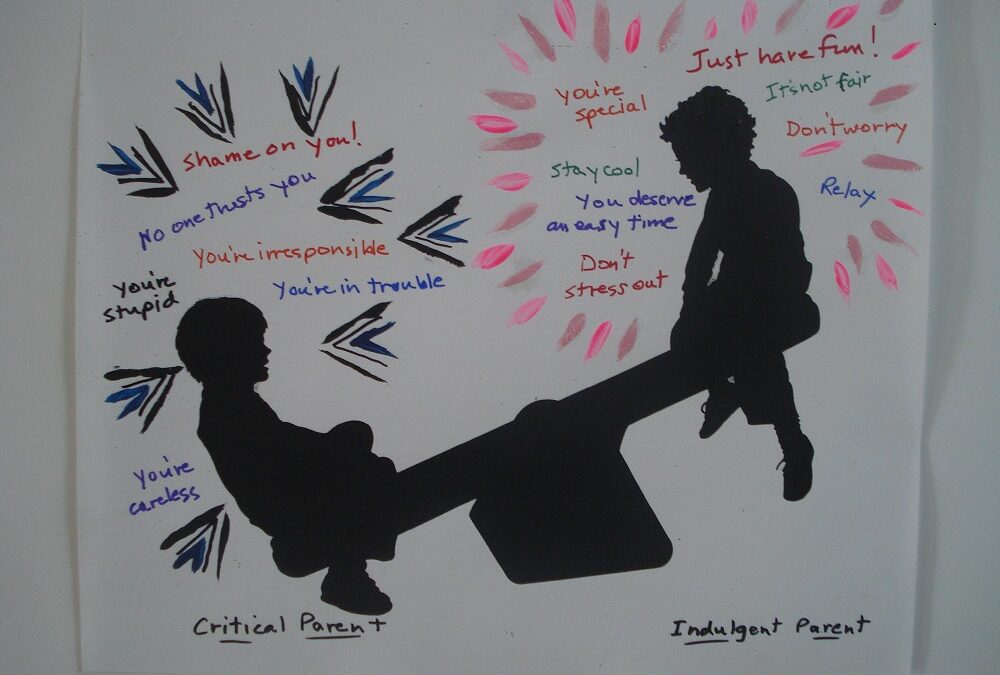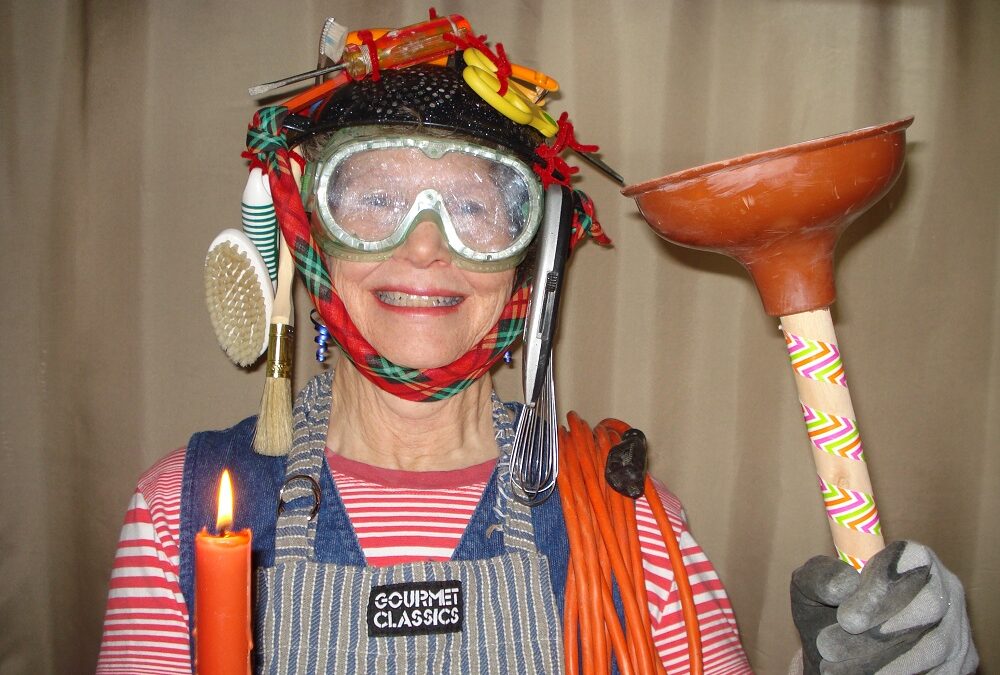
by wp-admin | Dec 9, 2021 | Exploring the Mental Fitness Formula

One day I decided that I should sort out for myself and my readers just how the FORMULA and the Adult-Parent-Child systems inter-connect and relate to Mental Fitness issues. I created the “Scaffold” here to capture this for us. In previous posts I’ve illustrated how these systems can combine by describing how I used them to combat fight-or-flight reactions in a few situations. Following the list of 12 Toxic Beliefs in the website discussion of the FORMULA, I noted that usually the first half of the beliefs belong to the Critical Parent and the next, to the Indulgent Parent. Then in Post #2 I admitted that I often think of myself as “we” instead of “I.”
In the scaffold drawing you can see arrows between the Adult-Parent-Child parts denoting how they influence each other. For you who like to have things sorted this way, I hope the scaffold helps. The entire scaffold will be more relevant in future posts. For now it might give you an overview for reference. For those who prefer a more intuitive approach, let me describe how I came to see my mind as multiple parts and why I find it helpful to divide it this way.
After my divorce in the 1970s I had to fend off waves of anxiety and dread that threatened to overwhelm me. I discovered that if my Adult could separate itself from my warring and confused Child and Parent parts, I could get my feet back on the ground. My own take on Eric Berne’s avatars (see ….) allowed me to function as a parent and graduate student despite frequent severe insomnia and panic attacks.
The fact that I could recognize and correct my toxic beliefs on my own was very reassuring and stabilizing. When negative feelings threatened to take over, I decided to use the reminder phrase, “Divide and conquer” to shove them aside. This gave my Adult the space to start sorting them out. My experiences as a mother, babysitter and teacher gave me a short-cut for how to comfort and reassure my own inner frightened or angry Child.
To sort out my Parent parts, I related each parent to half the beliefs and created reminder phrases for my Adult to use when they were too disruptive. “Stop exaggerating; none of this will kill us!” for my Critical Parent and “You’re just setting us up for future grief and we (Adult & Child) know it!” for my Indulgent Parent. These phrases respond to the basic message expressed through each Parent’s beliefs. They provided the space for my Adult to step in and revise any specific Child Brain Habits or Toxic Beliefs involved. “Divide and conquer!” worked so well that I’ve used it ever since.

by wp-admin | Dec 9, 2021 | Exploring the Mental Fitness Formula
A see-saw of self-indulgence and self-punishment happens when you’re set up by your Indulgent Parent (IP). Your Critical Parent (CP) keeps you on a short leash so you can’t get into trouble, scolding your Child each time you fail to measure up to one of the six toxic beliefs your CP holds. Your Indulgent Parent soothes your child into a false sense of security as it supports the next six toxic beliefs.
Let’s take the example procrastination, Toxic Belief # 9, that it’s more comfortable to avoid than to face problems or responsibilities. This belief caters to your Child’s focus on present satisfaction rather than future security. Your Adult may caution, “Do I want the ice cream cone now, or the next-size-smaller pants in a month?” Then your Indulgent Parent whispers, “Oh, it won’t hurt to enjoy just this little treat. You deserve it. Why do today what you can put off until tomorrow?” Or you have a project for school or work that seems so difficult that you can feel your Child’s resistance in your gut. Your IP croons, “You don’t have to start that today; why not wait until you feel more up to it tomorrow?” It might add “It’s just not fair that they expect so much from you,” to encourage Belief # 11, that you’re special so you deserve an easier path.
A month later you’re still in the same size pants, your boss gives you a corrective action and your school project gets a failing grade. Your IP may still tell you it’s not fair or you don’t deserve such treatment, but your Critical Parent torments you for being lazy, irresponsible and lacking in character. Set up by your Indulgent Parent, you’ve traded future well-being for present comfort and your self-esteem has taken a hit. When this see-saw continues, it leads to decreased self-confidence, energy, hope and possible even to depression. Addiction is a frequent companion to this process, where your IP encourages using the drug-of-choice to gain temporary relief from the stress created by your failure to face problems or responsibilities. This process is described in detail in Part II, Chapter 2 of Claim Your Own Mental Fitness.
Your Adult must act with a firm hand to grab the see-saw and tell you to get off. It can identify Belief #9 along with any others involved. For example, your avoidance might have begun after you had a disappointing experience that prompted toxic belief #7, that it’s unbearable to work hard for something and not get it. Your IP may chime in to say, “you tried hard enough to (lose weight, get a promotion, get an A), so why keep trying?” Your Child’s Black and White thinking could prevent you from looking for new ways to cope: it’s fair or unfair, it’s easy or it’s too hard, you’re special or worthless.
Once you’re off the see-saw, and seated with a cool glass of water under a friendly tree, your Wise Parent (WP) could remind you that: 1. Black-and-white thinking traps you into quitting or avoiding, not creative problem solving. It’s better to consider how to cope in a different way. 2. When you put off doing something you have to do, you create low-level anxiety, not peace. You may also end up with additional problems that are even harder to manage. 3 It’s not unbearable if your aren’t rewarded each time you work hard for something; everyone has to learn how to deal with this sometime.
Your Adult can help you break up a task into bite-sized pieces Your Wise Parent can offer encouraging words like, “a journey of a thousand miles begins with a single step” or “remember when you did this well before and how you got there.”

by wp-admin | Dec 9, 2021 | Exploring the Mental Fitness Formula
This picture shows that somebody wanted to create a unique statement at the beach. He or she thought about what to sculpt and carefully formed this octopus of damp sand. To make it more visible, the sculptor laid out seaweed to contrast with its arms. Now we can readily see this remarkable design. Social skills like assertiveness also require this kind of focus, caring and creative problem-solving. You just can’t fill a bucket with sand and dump it out. Your Adult needs to set goals, study what they’ll require and then work with your Child and Parent parts to develop and express your new skills.
In the early 1970s when I was in graduate school at the University of Iowa, the Women’s Movement rolled through. I sewed curtains for the new women’s center and then helped develop assertion training groups. These groups began because it was felt that, due to being treated as “less than” men, women lacked the skills and attitudes they needed to succeed in their work and enjoy healthy relationships.
You must be assertive to be mentally fit. Whether you’re a man or woman, you must be assertive to experience the social confidence and self-respect mental fitness brings. If not, others won’t fully open up to you because they can tell you’re not really open with them. Do you make a sarcastic joke at their expense? Do you pretend to be happy with them and then blow up occasionally? Do you vent your hurt and anger to others, thinking your comments won’t get back to the person you were afraid to confront? Do you usually withdraw and avoid real friendship because it’s just too hurtful and disappointing? In Claim Your Own Mental Fitness, Chapter 1, Part III, Friendship Holds the Keys, I describe in detail how being assertive opens the door for you to enjoy trust and harmony in your relationships.
As the sand sculptor formed the octopus, you can create within you the skills to be assertive. Using the FORMULA, your Adult must tune in to your Child’s anxiety and, with your Wise Parent, convince your Child that it does not need to go into fight-or-flight if another person gets angry or even dumps you. Because early human survival depended on social cooperation, social rejection became a trigger for fight-or-flight. The first time I decided to confront a person I really depended on for friendship (at about age thirty-one), I felt nauseous, my heart raced and my brain felt like spaghetti.
Here’s how I prepared myself. First, I re-read sections of Manuel Smith’s book, When I Say No, I Feel Guilty, where his students offer dialogue examples of how to talk assertively, not aggressively. I practiced what I could say in several variations of how the conversation might go. Once I had that down, my Adult worked on my toxic beliefs. (#1) No, I don’t need this friend’s approval or even her friendship, I just want it, my body can stay out of it.(#3) This friend is kind and fair-minded, she probably won’t blame or punish me for asking her to respond to my concern. (#9) No, it’s not more comfortable to avoid this conversation and keep getting privately upset with her. Finally, it’s not a black-and-white, either-or thing, that she’ll either be fine with this or reject me totally. Just because I’m uncertain and anxious doesn’t mean I can’t take this non-life-threatening risk to improve our friendship.
It was still very scary for me to gently open the topic I needed to discuss, and my body was still in take-off mode. My friend and I easily came to an understanding and I was launched on my assertive path. Consider the things you already care for thoughtfully: your home, your appearance, your crafts, your family, your career skills. This same kind of attention and persistence will also bring you the assertiveness you need to be mentally fit and the deeply rewarding relationships it makes possible.

by wp-admin | Dec 9, 2021 | Exploring the Mental Fitness Formula
All it takes is a point of light, a ray of hope in the darkest night… Randy Travis
Do you ever have moments when you get what seems like a great idea, but later you reconsider and decide you’d be crazy to try to do that? Here I am to show you what crazy looks like! I put this costume together when my son was six and we were going to a Halloween costume party. I sewed him the clown costume he wanted and designed my Mrs. Fixit trappings to express the longing I had to find full-time work as a therapist. Here’s how Mrs. Fixit lights her candle and keeps it burning.
In 1976 had my Ph.D., but lacked the confidence to pursue a therapist job during the mental health climate of the time. So I did part-time jobs that grew me in new ways. The most powerful was two years of marketing the Dale Carnegie Course. I was never very good at it, but I got over my HSP self-consciousness. Every day I’d cold-call on companies in the northwest Chicago area until about 3:00 pm, when the pain in my gut from fear made me go home to lie on the couch and regroup. Gradually, I realized that I shouldn’t take other people’s reactions to me personally and my gut became more comfortable for life. My favorite saying that our boss, Jim Bowen, gave us for this fear was “Nobody ever kicks a dead dog.” This helped me learn how to keep my candle burning indefinitely.
How do you decide when a “great” idea is great enough to pursue? Research to discover what else has been done in the field. Has your idea already been done; what came of it? Why? Maybe it wasn’t very well done, or you could do it in a different way to good effect. Or you might choose a different great idea to pursue. Get the training necessary for developing your idea. Finally, as Napoleon Hill advised in his book, The Master-Key to Riches, find a like-minded group to support you along the way.
If you’re confused about which direction you should take, because you have ideas in several areas, check out Pt. II Chapter 7 of my book, where there’s an exercise to help you set short- and long-term goals in key areas. Review your life to consider what you’ve loved doing and where you excel, then talk with trusted friends and mentors about what they think might be most fruitful for your to explore. Try some smaller, related projects to see how they work for you. You’ll likely discover personal limitations that prevent you from pursuing some ideas. Your Wise Parent should be assuring your Child that you have all the talents you need to live a rich and meaningful life. If it’s not doing that well enough, it’s time to review Part I of Claim Your Own Mental Fitness to learn how your Adult can transform some unexamined Toxic Beliefs (especially toxic Belief #2) into Wise-Parent guidance.
Elaine Aron (hsperson.com) has developed a video, Sensitive, about HSPs (Highly Sensitive Persons or those with sensory processing sensitivity) to help them find the confidence and acceptance they need to bring their talents into a world that tends to overwhelm them and snuff out their candles. As an HSP I’m grateful for her work, but I know that many non-HSP’s also get discouraged. Too many distractions of daily living pull us away from our goals. There are too many people with unresolved grief and anger who want to crush anyone who expresses enthusiasm and confidence. I guess it makes them feel better about their own dead candles, but all they’d have to do to reignite them is build up their own Wise Parents.
Remember it’s good to be a living dog and embrace life with energy and a sense of purpose. Celebrate where you are on your journey with a costume, picture or symbol that expresses where you are and keep your candle burning.

by wp-admin | Dec 9, 2021 | Exploring the Mental Fitness Formula
The deepest principle of human nature is the craving to be appreciated. (From the Dale Carnegie Course, 1976)
Here’s a new take on compassion and assertiveness! For a stronger Adult, a wiser Wise Parent and a more secure Child, consider the story of “Compassion, Assertiveness and the Pop-Bead Puppy.”
As I sat feeling exhausted in my doctor’s sunny waiting room, an older man holding a string of gold-colored pop-beads came over to me. He said “I want to give you something.” I was touched by his kind, gentle manner and invited him to sit next to me. Before retiring he’d traveled all around Louisiana working for Carpenter Tractors. Gradually he’d discovered that what he loved best to do was “put a smile on a someone’s face.” He said giving tiny pop-bead animals to people was his way to do that and he twisted the golden beads into a puppy for me.
I asked the Bead Man what he did when people got annoyed and treated him like he was trying to do something harmful to them. His face darkened and he said, “That’s bad.” After a moment he added, “but I know He (pointing upward as his face brightened) knows what I’m doing. I shared with him how I’d spent my life trying to find ways to do the same thing. I thanked him and as he left we laughed about how we both “just couldn’t get enough of those wonderful smiles.” This left me to ponder the issue of how humans react to what others offer them.
This gentle man felt really bad when people turned their eyes and hearts away from him as though he were panhandling for loose change. He wanted so much for people to give his gift a chance and could only keep going because he believed that a Higher Power recognized and appreciated him every time. Let’s consider what his motives might have been to perform this unusual behavior. Was he really panhandling for something else that would take from others much more than it gave? We’d call that self-serving and turn away. We could stay open to a friend who did that for a while, but not a stranger. Perhaps we’d fear that if we “gave him an inch, he’d take a mile,” and try to expand the contact into asking, say for a meal or a donation or more listening than we wanted to offer.
The Bead Man told me he just did this to see me smile. Why would he want to do that? He could be one of Elaine Aron’s HSP’s with “sensory processing sensitivity,” whose mirror neurons in their brain get more excited by smiles than the other 80% of the population, so he’d just be sharing what he loves. Chefs, artists, car dealers and most of the rest of us like to do that with others who enjoy the same things. They learn not to take rejection of their gifts as a rejection of themselves and to accept that what they offer may have limited appeal. Finally, he may have found this as a way to somehow transform grief from his life, like the mothers whose children were killed by drunk drivers joined to form MADD, with profoundly rooted zeal and determination to keep fewer children from dying this way.
When someone offers you a gift with an extra urgency that could make you suspicious and turn away, try staying open and allow your Adult to consider thoughtfully where this earnest person is really coming from. Unless there could actually be life-or-death consequences, let your Wise Parent assure your Child that your assertive Adult can set effective limits as needed. Remember that all of us want recognition and appreciation from each other, whatever our styles and the gifts we offer. You may find a kindred spirit along the way to brighten the path of your journey and soothe the pain we all find as we travel.

by wp-admin | Dec 8, 2021 | Exploring the Mental Fitness Formula
The previous post described how a worker might assume that a co-worker would see a situation the way he did and might have also believed that his managers would agree with and support him. When these expectations weren’t met he might enter the grief process. We call it empathy when people do understand each other’s point of view and feelings. But it’s a mistake to assume that we or others can do this accurately. It’s important for your Adult/Wise Parent team to know that your human nature is biased against differences. Then you can expect that it will take time and effort to get to know another person, before you assume anything about him. This will prevent a lot of disappointment and grief.
When your Adult can recognize your own biases against others who are different, it has a head start in your relationships. This knowledge alone can help reduce the power of your Toxic Beliefs. You’ve probably seen dogs or cats in fight-or-flight when they encounter an animal they consider different. When humans were evolving, it’s likely that offspring who couldn’t keep up were rarely protected at the expense of the tribe. Different tribes might have often been hostile and dangerous. Perhaps some of these might have been a human sub-species or otherwise look different in ways that were considered threatening. Because of how widespread human antagonism is toward those who seem different, it’s likely it had survival value sometime in our past.
Today we still see in our newspapers that fight-or-flight on a large scale happens between groups with differing religious beliefs, races, ancestors or tribes, customs, accents, gender identities, social status or amounts of wealth. I’ve described how people with different brain wiring must struggle to make their way in the larger society. Fitting in is close to a matter of life or death, to get a job, have a family or relax in your neighborhood. Young gay people and soldiers changed by war trauma often kill themselves because they can’t find a way to join in to our society. Poverty causes other divisions. Some turn their backs on those less fortunate as they struggle to climb the ladder of success, with varying degrees of compassion or guilt. The poor may develop a culture of distrust after too many set-backs overwhelm them.
It can give you peace to have your Adult remain aware of this bias as you cope with others. Anxiety about whether someone accepts or rejects you comes from your Parent’s warning that it’s dangerous not to have their approval. If you’re different from another person in ways they can notice right away, their human bias will probably push them to keep their distance. In that case, your Adult can keep your Parent and Child out of fight-or-flight by reminding them that Belief #1, that you must have the approval of any particular person, is false. When your Adult can keep you open to accepting what the other person offers, it will be more possible for time together and gradual comfort with your differences.
It’s sobering and calming to recognize your own tendency to over-react to others’ differences. You’ll be less likely to embrace Belief #3, that you or others should meet some set of expectations or suffer blame and punishment. Your Adult can’t be alert enough for you to escape entirely this human bias against people who are different. You may be fine with racial differences, but not religious. You may be repulsed by a homeless person or offended when a person expresses a cultural difference. You may be tempted to condemn those who haven’t provided as well for themselves as you have, and shun them to enjoy the company of wealthier people in your gated community.
This bias against those who are in some way different from us is a reality of your human nature that you must avoid denying. You need to grieve it all the way through, and accept it that it exists for both yourself and others. Then you’ll be happiest when you can transform this disturbing trait into a life-long challenge to overcome its influence. Polarized attitudes can lose some of their heat when you can have compassion instead of angry judgment for people who express this bias without realizing it. It’s a benefit of mental fitness to be able to help others discover this about themselves and re-set their relationships. You may have a future in the United Nations!
It’s time for humans to recognize this along with the other ancient wiring of our human nature. We need to live into our present, more evolved potential to solve human problems without automatic leaps into fight-or-flight over the differences between us.







